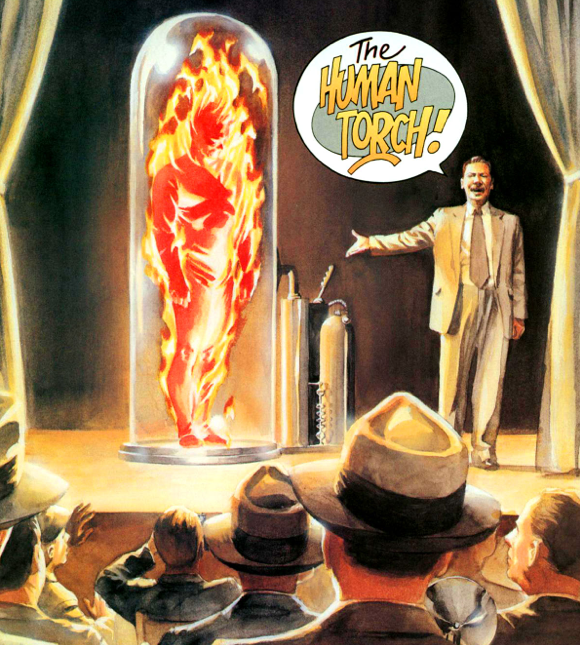
"Was it right that I should be given life, only to be placed in eternal imprisonment? To be tantalized with knowledge of the world, and denied the chance to savor it?"
Within the first few pages of Kurt Busiek's story the original Human Torch begs an existential question: is it fair that he is given life only to be denied the chance to actually live? Further, what is his role in the grand scheme of things? The Torch's moment of imprisonment isn't something that lasts very long, but the scenes and the language are indicative of a deeper story: a story of understanding, one that explores the psyches of these superheroes and allows readers to comprehend them on a far deeper level. That is why reading MARVELS is essential to your comics reading: within the pages of Busiek and Alex Ross' story is the exploration of characters we all know and love on a far deeper level. The language is beautiful and the layout of Ross's panels and art that compliment this story? In a word: it is breathtaking.
One of the great things about this particular trade are some of the extras you will find within its pages. The forward, for example, is written by Stan Lee: the man who created all these fantastic (no pun intended) characters. Stan covers a lot of what makes this particular story so compelling in his forward for the book. In it he explains that sure, when he first created these Marvel characters he intended that his characters and stories be "injected with realism" by using real cities, (like New York, for example) real buildings and the like but that it wasn't until MARVELS that the characters really felt authentic. Yes, these characters can do incredible things. Namor can fly, the Human Torch can light himself on fire by simply being exposed to oxygen, but the stories within the pages of MARVELS somehow feel so grounded that the characters feel like they actually exist, or could exist in our regular world. Through Ross' incredible ability to depict realism through painted art, and through Busiek's psychological exploration of these characters: that's what makes it feel as if these characters could simply jump off the pages and exist in our reality.

If you get the trade you will notice that it is split into different sections with each section focusing on a different character's story. The first focuses on the original Human Torch and Namor and is set around World War II in New York City. The panels feel real and dense, and Busiek makes sure to use language that was common for that era in New York. The result is a really beautiful, well written tale of two super-powered characters who seem to simply be misunderstood in that society but told primarily through the eyes of regular people who are witnessing these "Marvels" when they first come into existence, a detail which serves to further embed these characters in this realistic environment. Busiek takes it even further, leading his narrator, a journalist for The Daily Bugle, to beg where he and the rest of humanity fit in when these characters, these super-powered Marvels are becoming a reality.

"Marvels, I called them -- and that's what they were. Next to that -- what were we?…We weren't the players anymore, we were the spectators."
Humanity is no longer at the top of the food chain, and this is, in a sense something that is becoming more clear each and every day.The art is, of course, breathtaking and Ross even sneaks in a reference to artist Edward Hopper's famous 1942 Nighthawks painting which is considered one of the most famous and recognizable pieces of modern American art, a detail you should definitely look for if you manage to pick up this series.
The first section of the series serves as the introduction of these Marvels through the eyes of a younger man, and as the story progresses the man ages and more and more superheroes come into existence. Readers are introduced to some of the first mutants, as well as the Fantastic Four, Tony Stark and Captain America. And as the world is changing around our narrator, he continues to struggle with this idea that homo-sapiens are no longer superior beings, so how can he save his family in a climate that is changing and in a world that is day-by-day more and more out of his control? It's an interesting concept and is a big part of what makes reading this a very interesting experience.

Busiek's retelling of some of these classic stories is really well done and all tied together in a way that is organized and entertaining by the perspective of the narrator, a regular family man who is coming to the realization that the world around him is changing. Often when we read superhero stories, we fail to really consider the role of the bystander, and that's something Busiek brings to the very core of the story he is trying to tell. By having a narrator who is this seemingly normal guy who has born witness to many significant moments in the lives of these "Marvels," Busiek is essentially grounding the story in reality and making it feel like it could actually happen. Pair that with Alex Ross' absolutely breathtaking art and you have a recipe for a seemingly perfect superhero story. This is absolutely worth a look for anyone who is a fan of these characters and wants a new look at how they were originally introduced to the Marvel universe from a completely different lens.